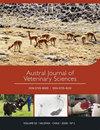智利安第斯高原怀孕vicuñas (Vicugna Vicugna)的能量平衡
IF 0.8
4区 农林科学
Q3 VETERINARY SCIENCES
引用次数: 3
摘要
能量不平衡可能是骆马生育率低的原因。本研究的目的是估计在智利高安第斯山脉圈养的一群怀孕骆马的营养状况的时间变化。研究中的假设是动物能够在旱季保持能量平衡。2015-2016年,分别于8月、10月和1月对6头怀孕骆马进行了检查。通过超声检查和血浆孕酮浓度评估生殖状况。测定每只动物的活重(LW)和体况评分(BCS: 1-5分制)。取血测定血浆总蛋白(Biuret法)、胆固醇(CHODPAP法)、甘油三酯(GPO-PAP法)、β-羟基丁酸(酶法)和非酯化脂肪酸(NEFA;酶比色法)。骆马各组的LW、BCS、血浆代谢物、总蛋白和孕酮浓度相似。雌性在怀孕期间没有增加LW, 1月份的BCS(2.9)低于骆驼类妊娠后期的推荐值(BCS 3.5)。NEFA和β-羟基丁酸值高于营养能量平衡下的预期值,分别表明了脂肪分解和生酮代谢反应。体重没有增加,NEFA值和β-羟基丁酸值表明,在智利安第斯山脉高海拔地区,怀孕骆马在旱季遭受负能量平衡。这可能导致流产,并导致畜群的低生育率。在严重干旱的年份,建议给怀孕的骆马提供食物补充,直到分娩。关键词:骆马,营养状况,负能量平衡。本文章由计算机程序翻译,如有差异,请以英文原文为准。
Energy balance of pregnant vicuñas (Vicugna vicugna) in the Chilean High Andes
Energy unbalance may be the cause of low fertility rates found in vicunas. The objective of this study was to estimate the temporal variation of the nutritional status in pregnant vicunas from a herd kept under captivity in the Chilean High Andes. The hypothesis under study is that animals are able to maintain the energy balance during the dry season. Six pregnant vicunas were examined in August, October and January (year 2015-2016). Reproductive status was estimated by ultrasonography and plasma progesterone concentration. Live weight (LW) and body condition score (BCS: 1-5 scale) were measured for each animal. A blood sample was taken to estimate the plasma concentrations of total protein (Biuret method), cholesterol (CHODPAP method), triglycerides (GPO-PAP method), β-hydroxybutyrate (enzymatic method) and non-esterified fatty acids (NEFA; enzymatic colorimetric method). Vicuna groups had similar LW, BCS, plus similar plasma concentrations of metabolites, total protein and progesterone. Females did not increase their LW during gestation and their BCS in January (2.9) was below the recommendations for late pregnancy in camelids (BCS 3.5). NEFA and β-hydroxybutyrate values were higher than those expected under nutritional energy balance signalling a lipolytic and ketogenic metabolic response, respectively. The absence of weight gain and the values of NEFA and β-hydroxybutyrate show that pregnant vicunas suffer a negative energy balance during the dry season in the Chilean High Andes. This can cause abortion and contribute to low fertility rates of the herds. It is suggested to provide pregnant vicunas with food supplements up to birthing, in years of severe drought. Key words : vicuna, nutritional status, negative energy balance.
求助全文
通过发布文献求助,成功后即可免费获取论文全文。
去求助
来源期刊

Austral Journal of Veterinary Sciences
Veterinary-General Veterinary
CiteScore
1.60
自引率
0.00%
发文量
18
期刊介绍:
Austral Journal of Veterinary Sciences (formerly Archivos de Medicina Veterinaria) publishes original scientific contributions in English, containing the latest developments and discoveries in veterinary sciences. The journal covers topics such as animal health and production, preventive medicine, zoonosis, pharmacology and therapeutics, methods of diagnosis, and other areas related to the veterinary field.
Austral Journal of Veterinary Sciences aims to divulge information about advances in veterinary medicine among universities, research centres, industries, government agencies, biologists, agronomists and veterinarians.
 求助内容:
求助内容: 应助结果提醒方式:
应助结果提醒方式:


